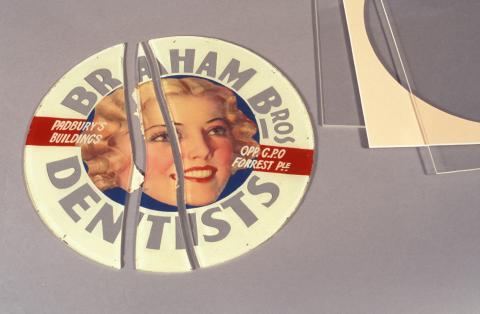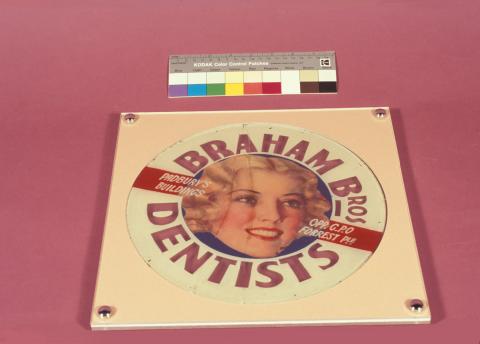Treatments
Examination
Thoroughly examine glass objects before storing, displaying or treating them in any way. Photographs, as well as notes and drawings, are useful for documenting the condition of objects before and after treatment.
Identify and clearly describe signs of deterioration. These include the presence of:
- cracks;
- old repairs;
- missing parts; and
- surface deterioration such as opacity, iridescence (or opalescence), crizzling, pitting, delamination and encrustations.
Also note any marks that indicate the place, date or method of manufacture and original contents of bottles and jars. Record the presence of any content residues. Ensure these residues are maintained during any subsequent treatment.
Keep accurate records of any treatments that are carried out and any changes that occur to the object while it is in storage or on display.
Cleaning
Only clean glass if it is in sound condition. Do not brush or wet any glass that has poorly adhering paint or surface weathering. Do not clean or chemically treat degraded glass (for example, exfoliated, crizzled, weeping, encrusted) or painted glass without consulting a conservator.
Guidelines for cleaning sound glassware are described below:
- use dry methods of cleaning first;
- remove surface dirt with a soft, clean cloth or a brush and gentle vacuum suction;
- if wet cleaning is necessary, then examine the object for any previous restoration, as some adhesives may be affected by water;
- clean the surface of repaired objects by applying distilled water with cotton swabs;
- to wash sound glassware, use cold or warm water (one litre) and add either a few drops of a concentrated, non-ionic detergent (such as Lissapol) or about 100 ml of pure soap solution. (The soap solution is prepared by dissolving one gram or about one teaspoon of pure soap flakes in a little hot water and adding enough cold water to make one litre.);
- use a large plastic container or a sink lined with towels;
- do not leave glass to soak in the water;
- only wash one object at a time;
- use soft brushes, cotton swabs or pliable sticks to remove stubborn dirt from wet glass;
- thoroughly rinse the glass with distilled or deionised water (in a large container) and drain on cloth or paper towelling;
- dry glass immediately with a soft cloth or by immersing it in a bath of methylated spirits; and
- use methylated spirits to remove stubborn dirt. Apply with a cotton swab, after testing any painted areas.
Rinse ‘weeping’ glass gently in deionised or distilled water. Do not leave it to soak. Dry it quickly and thoroughly by passing through two baths of methylated spirits. The ideal storage conditions for this type of glass is in an environment maintained at a relative humidity of 42 %. This will avoid further ‘weeping’.
Desalination
Place glass recovered from waterlogged land sites or marine environments immediately into sealed polythene bags to prevent drying. For glass recovered from the sea, partially fill the bags with seawater.
Washing is necessary to remove soluble salts, especially chloride salts, which will otherwise damage the glass when it is dried. Guidelines for desalination are described elsewhere (see the chapter Ceramics).
Removing Encrustations
Calcium encrustations can be removed mechanically from sound glass using pliable wooden spatulas and brushes while the glass is being desalinated. Calcium encrustations harden and become more difficult to remove if allowed to dry. Remove surface encrustations with great care as some forms of surface degradation, such as iridescence and exfoliation, are not apparent when the glass is wet.
Using polyphosphate water softeners, such as ‘Calgon’, to remove calcium encrustations is not recommended for any weathered glass as these are damaging to the glass (Horie 1989).
Use water softeners with caution for the treatment of strong, unweathered glass. A 2 % solution of Calgon in cold or warm water, sufficient to cover the object, may be used for this purpose. Initially the glass may be soaked for a few hours, periodically brushing away the calcium encrustations as they soften. Monitor this treatment carefully.
Repair
Joining broken glass is made difficult by the transparency of the material, its smoothness and the lack of ‘tooth’ or ‘key’ on broken edges (Figure 2).
Although epoxy resins have been used to repair glass their general use is not recommended. They tend to yellow as they age and are difficult to remove. A few epoxy resins have been developed specifically for conservation use and these have good ageing properties. They are available from conservation materials suppliers but appear to have a limited shelf life and are very expensive.
Some acrylic and polyvinyl acetate adhesives used for ceramic repair, Paraloid B-72 and UHU All Purpose Adhesive respectively, are also suitable for glass repair. The principles, guidelines and techniques for repair and reconstruction previously outlined for ceramics apply equally for glass fragments (see the chapter Ceramics). Points specific to glass are described below:
- before joining, degrease the edges of glass fragments with a cotton swab soaked with either methylated spirits or acetone;
- do not place tape, used to hold fragments together, on fragile surfaces;
- if the artefact is flat, lay fragments together on a flat surface and hold with tape;
- place a release material, such as wax paper or silicone release paper, under the glass fragments to prevent excess adhesive adhering to the support;
- paint the adhesive lightly over the joins. The adhesive will be drawn into the joins by capillary action; and
- remove excess adhesive later, using a sharp scalpel.
Figure 2: Broken glass – advertising sign.
(a) The glass sign before conservation and restoration.
(b) The glass sign after conservation and mounting behind Perspex.
Often synthetic casting resins are used for filling losses in glass. Gap filling causes some stress to the glass and the resins have a tendency to yellow. Only carry out filling if it is structurally or aesthetically necessary. It is a complicated procedure and consultation with a conservator is essential.
To strengthen a crack in glass to avoid further damage, dilute adhesive with an appropriate solvent and paint along the crack. Even a well repaired join in clear glass usually remains visible. This occurs because the refractive indices of the glass and that of the adhesive are usually different.
A broken glass stem may require dowelling as well as adhesive for a successful repair. The difficulty of drilling precise holes into a broken glass stem can be overcome by using a metal collar and a glass drill bit (Jackson 1982). The dowelling technique is complex and it is best to seek advice from a conservator.
Consolidation of glass is not generally recommended. If it is considered necessary, consult a conservator. Exfoliating, iridescent glass will lose its ‘rainbow’ colouring if a consolidant is used.














